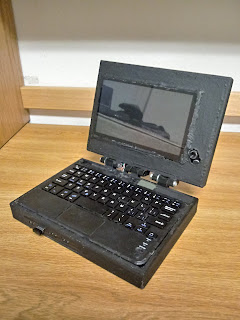77. LP-Laptop
This project will be utilizing a brand new single-board computer called the LattePanda. It has an Intel-based processor with an x86-intel architecture, 2 GB of RAM, 32 GB flash storage, and a preinstalled Arduino. In the flash storage, there is Windows 10 pre-installed (Ether activated or not), which means that whatever software is compatible with Windows OS will work on this board. The reason why I went for this project is mostly the software that can come in handy on Linux, such as the software Solidworks, a 3d-tool software.
To get started, you will need to get the various peripherals(keyboard, and mouse) to see if the Lattepanda works as intended. The board needed 5 volts to power up, and at least 2 amps of currents as it does heavy loading. You will need to get the same TFT screen from the other laptop builds (7 inches, 1024x600) as we are going for the same portable design.
 |
| <Testing> |
You will also need to have the body, lid, and cover parts all 3-d printed so that you can house the parts in together. The 3-d printed parts are similar to the other laptop project (being that it has hinges that hold the base and the lid together like a real laptop), but the width is shorter to ensure that the laptop is smaller and more compact than before.
Once you found that the LattePanda works as intended with the TFT screen, set up the parts in the 3-d printed parts. It won't hurt if you want to update Windows 10, though it will take a while, so be patient as the system updates. As this is more simplified, you will just need to wire up the board and the screen to the power bank module for the module to supply power. Make sure that the module can output at least 3 amps in total, or otherwise it will cause the board to restart due to the lack of power.
 |
| <Assembly> |
For the power source, you will need at least 6 18650 li-ion cells in parallel to ensure a big capacity for the laptop. Make sure that these cells are fully charged before they are used. Don't just get the old battery cells, or else the cells will suffer as they power up the laptop.
As for the keyboard, make sure that it's wireless, and has a touchpad to give it a laptop look. Pair it up to Windows 10, and if it all goes well, the Keyboard connects and will respond to every input. The mouse is optional, but it makes controlling the laptop much easier due to precision movement.
Like with the last project, it will include a USB hub for connecting more USB devices, so we will need to install it to the front hole of the 3-d printed base, and secure it with double-sided tape. The hinges of the base and lid are secured together with m5 screws tightly. This is to ensure that the lid is secured even when the screen is tilted, turned, and so on.
 |
| <Powering up> |
To have sound on this laptop, I went with the route of installing a small class-d amplifier to the base, along with some speakers. I solder the wires to the inputs of the audio jack, and then to the input of the amplifier. The speakers were wired to the output of the amplifier, and the power inputs are soldered to the Vcc and GND lines of the LattePanda. Double-check to make sure the sound is working by going to Windows 10, going to Sound, and doing various tests and configurations to check if the sound is working.
This is optional, but you can install the USB camera for the laptop so that you can take pictures/record subjects as an added function, If it comes with a microphone, that will be essential as it can be used in the software Cortana as you attempt to ask Cortana questions. Either way, this is just optional.
As everything is wired together (from the board to the screen, charging module to the batteries, and audio to the board) double-check to see if the connections are strong, and assemble the laptop as similar to the last laptop project.
 |
| <Near completion> |
Once everything is assembled together, you can try out the Windows 10 software, like maybe trying to install programs like Autodesk, Solidworks, and so on. Since it has a dedicated intel graphics chip, it will make 3-d processing easy on itself.
Whatever how you use the laptop, with several compatible software, makes this homemade laptop essential for places like school.
<Demostration>



Comments